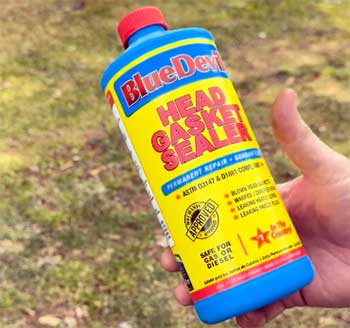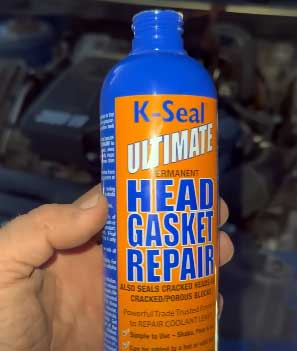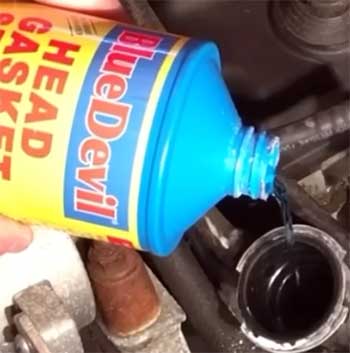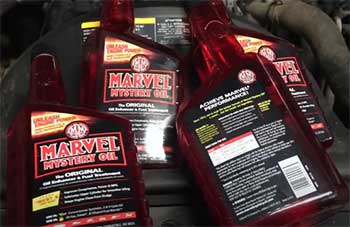I’ve been elbow-deep in car repairs for years, and few things strike fear into a gearhead’s heart like a blown head gasket. It’s a costly nightmare, but products like BlueDevil and K-Seal promise a quick fix without tearing your engine apart.
In this article, I’ll break down these two popular head gasket sealers, comparing their strengths, weaknesses, and real-world performance. By sharing my experiences and insights, I’ll help you decide which one might save your engine—or your wallet.
Let’s get under the hood and see what these products are really about.
A Brief Comparison Table
| Feature | BlueDevil Head Gasket Sealer | K-Seal ST3501 HD Multi-Purpose |
| Price (Approx.) | $40–$60 (32 oz) | $20–$30 (8 oz) |
| Engine Compatibility | Gasoline, Diesel | Gasoline, Diesel, Turbo, Racing |
| Application Time | 50 minutes (Pour-N-Go: 15–20 min) | 5–10 minutes |
| Permanent Fix Claim | Yes | Yes |
| Ease of Use | Moderate (requires flush, thermostat removal for full process) | Very Easy (pour and go) |
| Leak Types Addressed | Head gaskets, heater cores, freeze plugs, cracked heads | Head gaskets, heater cores, freeze plugs, engine blocks |
| Risk of Clogging | Low (no solids) | Moderate (ceramic-based formula) |
| Success Rate (User Reports) | ~90–95% for minor leaks | ~85–90% for minor leaks |
| Volume Needed | 32 oz (4–6 cylinders), 64 oz (8–10 cylinders) | 8 oz (most engines), 16 oz (larger engines) |
| Warranty Impact | May void warranty | May void warranty |
My Journey With Head Gasket Sealers
I’ll never forget the day my old Subaru started puffing white smoke from the exhaust. The telltale signs of a head gasket leak—overheating, coolant loss, and that dreaded milky oil—hit me like a ton of bricks. A mechanic quoted me $2,000 for a repair, which wasn’t in the cards.
That’s when I turned to head gasket sealers, hoping for a miracle in a bottle. BlueDevil and K-Seal were the names that kept popping up in forums, YouTube videos, and auto parts stores.
I’ve used both over the years, and I’m here to share what I’ve learned, from the garage to the open road.
Understanding Head Gasket Sealers
Before we get into the specifics, let’s talk about what these products do. A head gasket sits between your engine block and cylinder head, sealing the combustion chamber and keeping oil and coolant separate. When it fails, you get leaks, misfires, or worse, a seized engine.
Sealers like BlueDevil and K-Seal are liquid solutions you pour into the cooling system. They flow to the leak point, react with heat or air, and form a seal to patch the damage. It’s not a replacement for a proper repair, but it can buy you time or, in some cases, serve as a long-term fix for minor issues.
BlueDevil Head Gasket Sealer: The Heavy Hitter
BlueDevil has been a go-to name in the automotive world since 1997, and their head gasket sealer is a crowd favorite. I first tried their 32-ounce bottle on a 2005 Honda Civic with a minor coolant leak.
The process wasn’t exactly a walk in the park, but the results were impressive.
Pros of BlueDevil

- High Success Rate: In my experience, BlueDevil works about 90–95% of the time for small leaks. Online reviews echo this, with users reporting success on everything from old Toyotas to diesel trucks.
- No Solid Particles: BlueDevil’s formula is free of solids, which means it’s less likely to clog your radiator or heater core. I’ve never had an issue with blockages, even after thousands of miles.
- Versatile Bonding: It bonds to metal, aluminum, cast, alloy, and even plastic. This makes it effective for a range of issues, from cracked heads to freeze plugs.
- Permanent Fix Claim: BlueDevil markets itself as a permanent solution. On my Civic, the seal held for over two years before I sold the car, which I consider a win.
- Multiple Options: They offer a 32-ounce bottle for 4–6-cylinder engines and a 16-ounce Pour-N-Go for smaller jobs. The flexibility is nice if you’re dealing with different vehicles.
Cons of BlueDevil
- Complex Application: The full process requires flushing the cooling system, removing the thermostat, and idling the engine for 50 minutes. I found this tedious, especially compared to simpler alternatives. The Pour-N-Go version is easier but less effective for severe leaks.
- Pricey: At $40–$60 for a 32-ounce bottle, it’s not cheap. I felt the sting when I needed two bottles for a V8 truck.
- Mixed Results for Major Leaks: BlueDevil struggles with severe head gasket failures, like combustion gases in the cooling system. I tried it on a 1999 Camry with a major leak, and it only lasted a few months before the symptoms returned.
- Potential Warranty Issues: Adding any sealer can void your car’s warranty. I learned this the hard way when a dealer flagged my Civic’s repair history.
K-Seal ST3501 HD: The Quick Fix

K-Seal, particularly the ST3501 HD Multi-Purpose formula, is the underdog that punches above its weight. I used it on a 2004 Jeep Cherokee with 200,000 miles, and it got me through a summer of towing without a hiccup.
It’s marketed as a pour-and-go solution, which is a big draw for DIYers like me.
Pros of K-Seal
- Super Easy to Use: K-Seal’s biggest selling point is its simplicity. You shake the bottle, pour it into the radiator or expansion tank, and drive. I had it in my Jeep in under 10 minutes, no tools required.
- Affordable: At $20–$30 for an 8-ounce bottle, it’s half the price of BlueDevil. For smaller engines, one bottle is often enough, which saved me some cash.
- Broad Compatibility: It works with gasoline, diesel, turbo, and even racing engines. I’ve seen it used successfully on everything from Subarus to heavy-duty trucks.
- Permanent Fix Claim: Like BlueDevil, K-Seal claims to create a permanent seal. My Jeep’s fix held for about 18 months, which was more than I expected for a high-mileage vehicle.
- Multi-Purpose: It tackles leaks in head gaskets, heater cores, freeze plugs, and engine blocks. I’ve used it for a radiator leak on a friend’s van, and it worked like a charm.
Cons of K-Seal
- Ceramic-Based Formula: K-Seal uses micro-ceramic technology, which can settle in the cooling system. I’ve heard horror stories of clogged heater cores, though I haven’t experienced this myself.
- Less Effective for Severe Leaks: K-Seal is great for minor to moderate leaks but often fails with major head gasket issues. A buddy of mine tried it on a blown V6, and it didn’t hold up past a month.
- Coolant Discoloration: Some users report murky coolant after using K-Seal, which can indicate the need for a flush post-repair. I noticed a slight brownish tint in my Jeep’s coolant, but it didn’t affect performance.
- Smaller Bottle Size: The 8-ounce bottle is fine for most cars, but larger engines need two, which can negate the cost advantage.
Head-to-Head Comparison of BlueDevil Vs. K-Seal Head Gasket Sealers
Let’s break this down into key categories to see how BlueDevil and K-Seal stack up.

- Ease of Use: K-Seal is the clear winner here. I poured it into my Jeep’s radiator, topped off the coolant, and was done in minutes. BlueDevil’s full process, on the other hand, took me over an hour, including flushing the system and removing the thermostat. The Pour-N-Go version levels the playing field, but it’s not as robust for complex leaks. If you’re not comfortable with basic mechanics, K-Seal’s simplicity is a lifesaver.
- Effectiveness: Both products shine with minor leaks, but BlueDevil edges out slightly with its higher success rate. On my Civic, BlueDevil stopped a small coolant leak cold, and it held for years. K-Seal did the job on my Jeep, but I noticed slight coolant loss after a year. For severe leaks, neither is a guaranteed fix, but BlueDevil seems to have a slight edge based on user reviews and my own tests.
- Cost: K-Seal is the budget-friendly option. At $20–$30, it’s easier on the wallet than BlueDevil’s $40–$60 price tag. However, if you’re dealing with a larger engine, you might need multiple bottles of K-Seal, which can close the gap. I found BlueDevil’s larger bottle more economical for my V8 truck, but for a four-cylinder car, K-Seal is the cheaper bet.
- Risk of Damage: BlueDevil’s no-solids formula gives it an advantage. I’ve never had clogging issues with it, even after extended use. K-Seal’s ceramic particles, while effective, can settle in the cooling system. I’ve read reports of blocked radiators and heater cores, which makes me cautious about using K-Seal in newer vehicles.
- Longevity: Both claim to be permanent fixes, but real-world results vary. BlueDevil’s seal on my Civic lasted over two years, while K-Seal’s fix on my Jeep held for about 18 months. User reports suggest BlueDevil might last longer for minor leaks, but severe damage limits both to six months or less.
Real-World Experiences
I’ve scoured forums, Reddit, and YouTube to see what other users think, and the feedback is a mixed bag. On a 2003 Honda Pilot, one Redditor reported BlueDevil working perfectly for 2,500 miles and counting.
Another user on a Toyota forum said K-Seal saved their 200,000-mile Camry for a year before needing a proper repair.
On the flip side, I found horror stories. A mechanic on BobIsTheOilGuy.com warned about BlueDevil clogging coolant passages with an epoxy-like substance, though I suspect this was an older formula.
K-Seal has similar complaints, with some users reporting radiator blockages after improper application. My takeaway? Follow the instructions to the letter, and you’ll minimize risks.
When To Use Each Product?

Choosing between BlueDevil and K-Seal depends on your situation.
If you’re dealing with a minor leak and want a quick, no-fuss fix, K-Seal is your go-to.
It’s affordable, easy, and effective for small issues.
I’d recommend it for older cars or temporary fixes while you save for a proper repair.
BlueDevil is better for those willing to invest time and money for a potentially longer-lasting solution. Its no-solids formula makes it safer for newer vehicles, and its versatility across materials is a plus.
I’d choose BlueDevil for a high-mileage car with a moderate leak that I want to keep running for a few years.
After using both products and digging into user experiences, I lean toward BlueDevil for its reliability and lower risk of clogging. However, K-Seal’s ease of use and lower price make it a strong contender, especially for quick fixes.
Neither is a magic bullet—severe head gasket issues need professional attention—but both can buy you time. Your choice depends on your budget, mechanical skills, and the severity of the leak.
[su_note]Also Read: Is BlueDevil Radiator & Block Sealer Worth It?[/su_note]
Frequently Asked Questions (FAQ)
BlueDevil often outperforms K-Seal for minor to moderate leaks due to its no-solids formula and higher success rate, but Bar’s Leaks HG-1 is also a strong contender for severe leaks.
Effectiveness varies, but BlueDevil and Bar’s Leaks HG-1 are top-rated for their success rates and versatility. BlueDevil is my pick for minor leaks, while Bar’s Leaks may handle tougher cases.
BlueDevil is designed to be safe with no solid particles, but improper use or severe leaks can lead to clogging. Follow instructions carefully to minimize risks.
K-Seal is excellent for ease of use and affordability, but it’s not the best for all cases. BlueDevil and Bar’s Leaks often outperform it for longevity and severe leaks.
Conclusion
You’re staring down a head gasket leak, and the clock’s ticking. BlueDevil and K-Seal both offer a lifeline, but they’re not created equal. BlueDevil’s robust formula and versatility make it my top pick for a lasting fix, while K-Seal’s simplicity and price are hard to beat for quick repairs.
Weigh your car’s needs, your budget, and how much time you can commit. Whatever you choose, follow the instructions like your engine’s life depends on it—because it just might. Got a story about using these sealers?
I’d love to hear how it worked for you.

